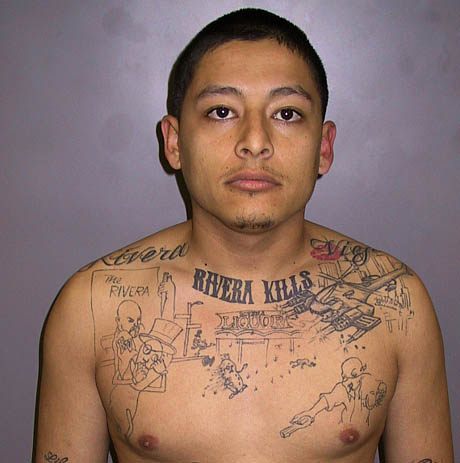
IMAGE: Anthony Garcia, photographed by the Los Angeles County Sheriff’s Department, via the Los Angeles Times.
25-year-old gang member Anthony Garcia spent years adding detail to the drawing of a Pico Rivera liquor store on his chest, including a loop of Christmas fairy lights strung along the ceiling and the bowed street lamp and sign across the way. But this is no body art homage to a favoured alcohol purveyor.
Instead, Garcia’s drawing commemorates a murder scene, complete with a prone Mr. Peanut-figure, riddled with bullets. According to Robert Faturechi, who covered the bizarre story in the Los Angeles Times, “in gang slang, the word ‘peanut’ is used to derisively describe a rival gang member.”
Unfortunately for Garcia, after he was taken back to a Los Angeles police station on suspicion of driving on a suspended license, a routine photograph of his tattoos helped convict him of the unsolved murder of 23-year-old John Juarez — the “peanut” he had permanently inked onto his upper body.
Faturechi reports that “suspected gang members typically are asked to remove their shirts and have their tattoos photographed by graffiti team deputies,” as they often use the same tags on their bodies as they do on walls and buses around the city. Garcia’s tattoo made it into that collection, where it was eventually seen by Los Angeles County Sheriff’s homicide investigator, Kevin Lloyd. Every single detail of the tattoo, down to the angle of the dead man’s body and the shop signage, precisely matched the scene of a 2004 liquor store killing of Juarez, a crime that stumped Lloyd for more than four years.
You can read how Garcia’s tattoo was used to extract a confession over at the L.A. Times. Meanwhile, as unlikely as it undoubtedly is, I can’t help but imagine this Pico Rivera liquor store as just one example of an entire cartography of unremarkable fried chicken restaurants, taco stands, and corner shops commemorated in this way — a gallery of otherwise anonymous sites, without web sites or Facebook fan pages, that are celebrated nonetheless on the illuminated skin of America’s gangs.
Thanks to the L.A. Times architecture critic, Christopher Hawthorne, for the link.

